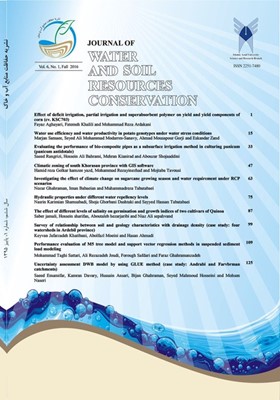Performance Evaluation of M5 Tree Model and Support Vector Regression Methods in Suspended Sediment Load Modeling
Subject Areas : Farm water management with the aim of improving irrigation management indicatorsMohammad Taghi Sattari 1 , علی رضازاده جودی 2 , Forugh Safdari 3 , فراز قهرمانیان 4
1 - Department of Water Engineering, Agriculture Faculty, University of Tabriz.
2 - Young Researchers and Elite Club, Maragheh Branch, Islamic Azad University, Maragheh, Iran.
3 - دانش آموخته کارشناسی ارشد، مهندسی منابع آب، دانشکده کشاورزی، دانشگاه تبریز
4 - دانش آموخته کارشناسی ارشد عمران-آب، دانشگاه آزاد اسلامی واحد اهر، اهر، ایران.
Keywords: M5 tree model, sediment load estimation, data mining, support vector regression and Aharchay,
Abstract :
Sediment transport has always affected the river and civil structures and the lack of knowledge about its exact amount causes high damages. Therefore, it is very important to properly estimate the sediment load in rivers in terms of sediment, erosion and flood control. This study used two new data mining methods including M5 model tree and support vector regression comparing with the classic method of sediment rating curve to estimate the suspended sediment load in Aharchay River. To assess the performance of the used methods, three criteria including the correlation coefficient, root mean square error and mean absolute error were used. Analyzing the sensitivity of models to the input variables, it was found that the variable of flow discharge in the current month had the greatest effect on the amount of suspended sediment load. The results showed the high accuracy of new data mining methods in comparison with the sediment rating curve. Although, both considered data mining methods had more accuracy and less error compared to the conventional sediment rating curve, given the simple understandable linear relationships provided by the M5 model tree, this method is recommended for similar cases.
حسین زاده دلیر، ع.، فرسادیزاده، د. و قربانی، م ع. 1388. تاثیر نوسانات سطح آب و دبی جریان بر میزان بار معلق با استفاده از شبکههای عصبی مصنوعی (مطالعه موردی: رودخانه اهر چای). دانش آب و خاک.19(1): 23-33.
خزائی پول، ا. و طالبی، ع. 1392. بررسی امکان پیشبینی رسوبات معلق با استفاده از ترکیب منحنی سنجه رسوب و شبکهی عصبی مصنوعی (مطالعه موردی: رودخانه قطورچای، پل یزدکان). پژوهشهای فرسایش محیطی. 9: 73-82.
داننده مهر، ع.، علیایی، ا. و قربانی، م.ع. 1389. پیش بینی بار معلق رودخانه ها بر مبنای دبی جریان با استفاده از برنامه ریزی ژنتیک. پژوهشهای آبخیزداری (پژوهش و سازندگی). 88 (2):44-54.
دهقانی، ن. ووفاخواه، م. 1392. مقایسه روشهای تخمین رسوب معلق روزانه با استفاده از روشهای منحنی سنجه رسوب و شبکه عصبی (مطالعه موردی: ایستگاه قزاقلی،استان گلستان). پژوهشهای حفاظت آب و خاک. 20(2): 1-10.
رجبی، م.، فیضاله پور، م. و روستایی، ش. 1394. استفاده از مدل تبرید تدریجی عصبی (NDE) در تخمین بار معلق رسوبی و مقایسه آن با مدل ANFIS و RBF (مطالعه موردی: رودخانه گیویچای). جغرافیا و توسعه، 39(2): 1-16.
مهریزی حائری، ع ا، 1382. دادهکاوی: مفاهیم، روشها و کاربردها. پایاننامه کارشناسی ارشد آمار اقتصادی و اجتماعی، دانشکده اقتصاد، دانشگاه علامه طباطبائی.
شهرابی، ج. و حجازی، ط ح. 1391. داده کاوی. انتشارات دانشگاه امیرکبیر.تهران.131صفحه.
صفوی، ح. 1390. هیدرولوژی مهندسی، انتشارات ارکان دانش، چاپ سوم، اصفهان. 699 صفحه.
Alberg, D., Last, M. and Kandel, A. 2012. Knowledge Discovery In Data Streams With Regression Tree Methods. Wiley Interdisciplinary Reviews Data Mining Knowledge Discovery, 2: 69-78.
Aytek,A.andKisi,O. 2008.A Genetic Programming Approach to Suspended SedimentModelling. Hydrology, 351: 288-298.
Battacharya, B. and Solomatine, D. P. 2006. Machine Learning in Sedimentation Modeling, Neural Network, 19. pp: 208-214.
Ghorbani, M. A., Hosseini, S. H., Fazelifard, M. H. and Abbasi, H. 2013. Sediment Load Estimation by MLR, ANN, NF and Sediment Rating Curve (SRC) In Rio Chama River. Journal of Civil Engineering and Urbanism, 3(4): 136-141.
Graziose, J. 2013. Is My Data Normal? Using Technology to Test For Normality. 25th anniversary International Conference on Technology in Collegiate Mathematics, 169-175.
Heng, S. and Suetsugi, T. 2013. Using artificial neural network to estimate sediment load in ungauged catchments of the Tonle Sap River Basin, Cambodia. Journal of Water Resource and Protection, 5: 111-123.
Kakaei Lafdani, E., Moghaddam Nia, A. and Ahmadi, A. 2013. Daily suspended sediment load prediction using artificial neural networks and support vector machines. Hydrology, 478: 50-62.
Kao, Sh., Lee, T. and Milliman, J. D. 2005. Calculating Highly Fluctuated Suspended Sediment Fluxes From Mountainous Rivers In Taiwan. Terrestrial, Atmospheric and Oceanic Sciences, 16(3): 653-675.
Kia, E., Emadi, A. R. and Fazlola, R. 2013. Investigation and Evaluation of Artificial Neural Networks in Babolroud River Suspended Load Estimation. Journal of Civil Engineering and Urbanism, 3(4): 183-190.
Kisi, O. and Shiri, J. 2012. River Suspended Sediment Estimation by Climate Variables Implication: Comparative Study among Soft Computing Techniques. Computer and Geosciences, 43: 73-82.
Kumar Goyal, M. 2014. Modeling of Sediment Yield Prediction Using M5 Model Tree Algorithm and Wavelet Regression. Journal of Water Resources Management, 28: 1991-2003.
Nourani, V. 2009. Using Artificial Neural Network (ANNs) For Sediment Load Forecasting of Talkherood River Mouth. Urban and Environmental Engineering, 3(1): 1- 6.
Ozturk, F., Apaydin, H. and Walling, D. E. 2001. Suspended Sediment Loads through Flood Events for Streams of Sakarya Basin. Journal of Engineering Environment, 25, 643-650.
Platt, J. 2000. Fast Training Support Vector Machine Using Sequential Minimal Optimization. http://www.research.microsoft.com/_jplatt. 41-65.
Quinlan, J. R. 1992. Learning with Continuous Classes, Singapore. In proceedings AI, 92 (Adams & Sterling, Eds). World Scientific, pp: 343-348.
Rajaee, T., Mirbagheri, S.A., Nourani, V., and Alikhani, A. 2010 Prediction Of Daily Suspended Sediment Load Using Wavelet And Neuro Fuzzy Combined Model. Environment Sciences, Tech, 7 (1): 93-110.
Shapiro, S. S.; Wilk, M. B. 1965. An analysis of variance test for normality (complete samples). Biometrika 52 (3–4): 591–611.
Stephens, M.A. 1979. Test of fit for the logistic distribution based on the empirical distribution function, Biometrika, 66(3), 591–5.
Vapnik, V. N. 1995. The Nature ofStatistical Learning Theory. Springer, NewYork. 314p.


